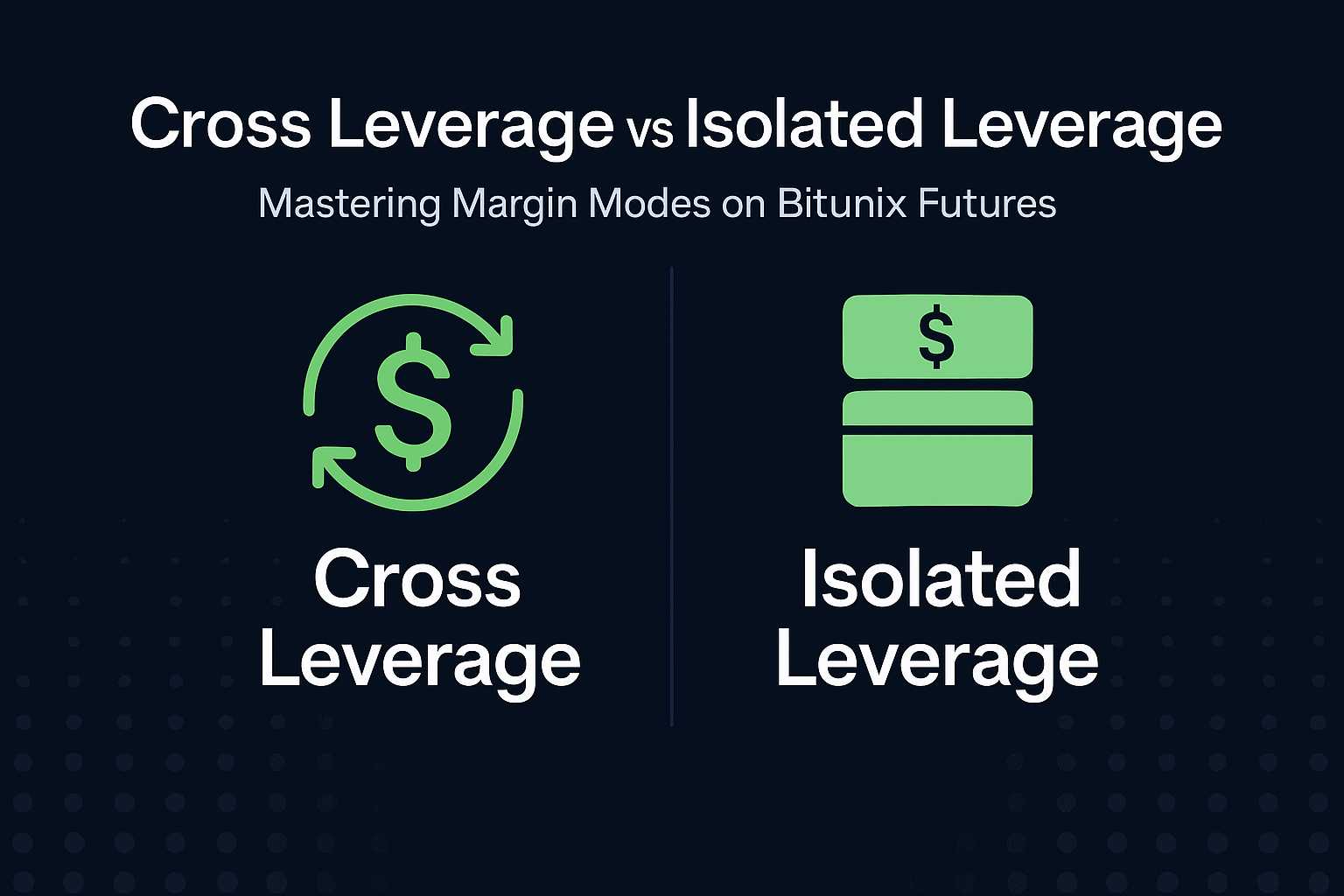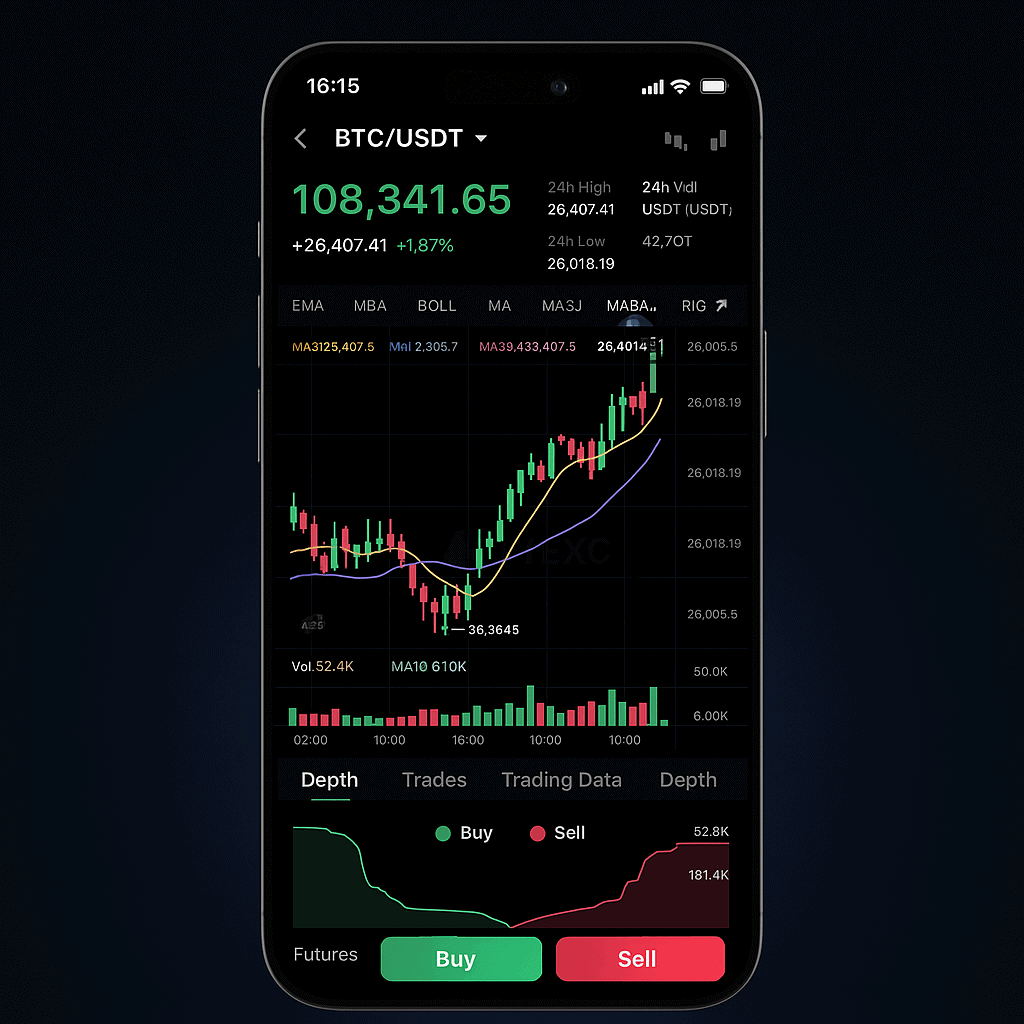
Navigating crypto futures means more than just understanding leverage; it means choosing the right margin mode for your trades. This critical decision directly impacts your risk exposure and potential for liquidation. Many traders, especially those new to derivatives, misunderstand the fundamental differences and implications when faced with Cross leverage vs isolated leverage. A wrong choice here can significantly impact your trading outcomes.
This guide will demystify the core differences between Cross leverage vs isolated leverage, explaining how each works and how to apply them strategically on Bitunix for better risk management. By the end, you’ll be equipped to choose the margin mode that best suits your trading style and risk tolerance, transforming confusion into confident control.
Ready to master your margin modes and trade crypto futures confidently? Sign up for Bitunix today for precise control over your leveraged positions!
Cross Leverage vs Isolated Leverage Comparison
Understanding the fundamental differences between Cross leverage vs isolated leverage is crucial for risk management. Here’s a quick overview:
| Feature | Cross Margin (Cross Leverage) | Isolated Margin (Isolated Leverage) |
|---|---|---|
| Collateral | Entire available balance in futures wallet | Specific amount allocated to a single position |
| Liquidation | Higher threshold; risk of losing entire balance | Lower threshold; risk confined to allocated margin |
| Risk Management | Centralized; requires active monitoring of total balance | Decentralized; easier to manage risk per trade |
| Flexibility | More flexible for multiple positions, hedging | Less flexible; each position self-contained |
| Initial Use Case | Hedging, long-term positions, experienced traders | Speculative trades, beginners, single high-risk trades |
Understanding Cross Leverage: How It Works and Its Implications
Cross margin, often referred to as Cross leverage, is a margin mode where your entire available balance in your futures wallet acts as collateral for all your open positions. Instead of assigning a specific amount of capital to each individual trade, the system uses your total wallet balance to prevent any single position from being liquidated.
The primary benefit of Cross leverage is its flexibility. It offers a higher liquidation threshold because all your funds are pooled to support any losing positions. This can be advantageous in volatile markets, as minor price fluctuations are less likely to trigger immediate liquidation for individual trades. It’s often favored by experienced traders who manage multiple positions or use hedging strategies, as it provides a safety net across their entire portfolio.
However, the main implication of Cross leverage is that if the market moves significantly against your positions, you risk losing your entire futures wallet balance, not just the margin allocated to a single trade. It requires active monitoring of your overall portfolio health.

Understanding Isolated Leverage: How It Works and Its Implications
In contrast to Cross leverage, Isolated margin (or Isolated leverage) means that only a specific, predefined amount of capital is allocated as margin for a single, individual position. The risk of that position is then “isolated” to only that allocated amount.
The primary advantage of Isolated leverage is its confined risk. If a trade goes sour, your maximum loss is limited to the margin you initially put into that specific position. Your remaining funds in your futures wallet are untouched and safe from that particular trade’s outcome. This makes it highly suitable for speculative trades, where you want to cap your downside risk on a single high-conviction bet. It’s also often recommended for beginners, as it simplifies risk calculation per trade and prevents unforeseen losses impacting their entire balance.
The downside, however, is that individual positions under Isolated leverage have a lower liquidation threshold. Smaller price movements against the position can lead to quicker liquidations because the collateral is limited. This requires more active management of individual positions. For a deeper look at Bitunix’s overall offerings, read our comprehensive Bitunix Review. To grasp the basics, ensure you understand How Crypto Futures Leverage Works before choosing a margin mode.
Cross Leverage vs Isolated Leverage: A Strategic Comparison
The choice between Cross leverage vs isolated leverage is not about one being inherently “better” than the other. Instead, it’s about choosing the margin mode that strategically aligns with your trading style, risk tolerance, and the nature of your trades.
Here’s a strategic comparison to help you decide:
- Risk Exposure:
- Cross Leverage: Spreads risk across your entire futures wallet. A single losing trade draws from the collective pool, increasing the risk to your total balance.
- Isolated Leverage: Confines risk to the specific margin allocated for that position. Your other funds are protected from that trade’s outcome.
- Liquidation Management:
- Cross Leverage: Offers a higher tolerance for price swings for individual positions, but a deep drawdown can lead to the liquidation of your entire margin balance.
- Isolated Leverage: Individual positions are more susceptible to liquidation with smaller price movements, as their margin is limited.
- Flexibility & Control:
- Cross Leverage: More flexible for managing multiple positions or hedging, as profits from one trade can cover losses in another.
- Isolated Leverage: Provides stricter control over risk per individual trade, making it easier to define maximum loss for each speculative venture.
- Use Cases:
- Cross Leverage: Ideal for those who have a strong conviction in their overall portfolio direction, employ hedging strategies, or prefer not to micromanage individual positions. It’s often used with lower leverage ratios.
- Isolated Leverage: Best for highly speculative trades, trying out new strategies, or when you want strict control over the maximum loss for a single trade. It’s often paired with higher leverage ratios on individual bets.
Understanding your own risk tolerance and current trading strategy is paramount when deciding between Cross leverage vs isolated leverage. Bitunix makes this decision easier by providing clear options and intuitive management. For a comprehensive understanding of Bitunix’s overall security, find out Is Bitunix Safe?

Bitunix Futures: Practical Application of Cross Leverage vs Isolated Leverage
Bitunix is designed to empower traders with practical control over their margin modes, ensuring that managing Cross leverage vs isolated leverage is as intuitive as possible. The platform provides a clear and user-friendly interface that makes selecting and adjusting your margin mode simple, even for those new to these concepts.
Here’s how Bitunix helps you manage your margin effectively:
- Intuitive UI for Margin Selection: On Bitunix, when you open a futures trade, you’ll find clear buttons or dropdowns to select either Cross or Isolated margin. The platform often includes brief explanations or warnings to guide your choice, helping you understand the implications before committing.
- Seamless Switching: Bitunix allows you to switch between Isolated and Cross margin modes for an open position (under certain conditions), providing flexibility if your strategy or market conditions change. This dynamic control is essential for experienced traders and a learning opportunity for beginners.
- Real-time Margin Monitoring: For Cross leverage, Bitunix displays your overall wallet balance and margin ratio, allowing you to monitor the health of your entire portfolio. For Isolated leverage, it clearly shows the specific margin allocated to each position, making it easy to track individual trade risks. This real-time data helps in efficient margin management and timely decision-making.
- Streamlined Onboarding: Bitunix’s fast and convenient sign-up process means you can quickly access the platform and begin exploring these margin modes. You can focus on learning and applying your knowledge without lengthy initial setup procedures.
For more insights into various margin trading concepts, reliable financial education sites offer extensive resources.
Lucas Tran’s Expert Opinion: Making Smart Margin Choices on Bitunix Futures
This piece features insights from Lucas Tran, a Certified Blockchain Analyst with over 7 years of hands-on experience in crypto trading, DeFi ecosystems, and early-stage exchange platforms. As the lead researcher at CryptoPulseHQ, Lucas specializes in uncovering high-potential tools across altcoin markets, launchpads, and privacy-first trading platforms. Since entering the space in 2016, Lucas has helped thousands of readers navigate the volatile world of digital assets with clear, actionable guidance. He’s contributed to portfolio strategy workshops, trading research, and technical tutorials across multiple global platforms. At CryptoPulseHQ, his mission is simple: help everyday traders make smarter, safer, and faster decisions — even in the most unpredictable market cycles.
As someone who’s navigated the crypto markets for years, I can confidently say that the decision between Cross leverage vs isolated leverage is one of the most critical you’ll make in futures trading. It’s not just a technical setting; it directly impacts your risk exposure and overall strategy.
Bitunix understands this implicitly. Their platform does an excellent job of presenting these options clearly and intuitively, making it easier for traders, especially beginners, to understand the implications of each choice. The ability to see your margin status in real-time, coupled with clear explanations of Cross and Isolated modes, is paramount for responsible margin trading. This commitment to user clarity and robust functionality is a key reason why Bitunix stands out as a preferred platform for managing these crucial trading elements.

Beyond Margin: The Bitunix Advantage for Futures Traders
While mastering Cross leverage vs isolated leverage is fundamental, Bitunix offers a comprehensive suite of features that enhance your overall futures trading experience. The platform is designed to cater to both the nuances of margin management and the broader needs of active crypto traders.
Key aspects of Bitunix’s full trading ecosystem include:
- Low Trading Fees: Bitunix boasts highly competitive futures fees (0.02% maker / 0.06% taker). These low rates are a significant advantage, as they minimize trading costs regardless of which margin mode you choose, benefiting your overall profitability.
- Diverse Trading Pairs: With over 700+ diverse trading pairs available, Bitunix provides ample opportunities to apply your refined understanding of margin modes across a wide array of cryptocurrencies.
- Copy Trading: This feature allows you to observe how experienced traders manage their positions, including their choice and application of margin modes, offering a practical learning experience.
- 24/7 Multilingual Customer Support: Swift and reliable assistance is crucial when dealing with leveraged positions and margin-related queries. Bitunix ensures help is always available.
Explore our guide to the Best Crypto Exchanges in 2025. For a deeper dive into amplified trading, check out our recent post on High Leverage Crypto Futures.
The Verdict on Cross Leverage vs Isolated Leverage: Trade Smarter with Bitunix
Understanding the distinct characteristics of Cross leverage vs isolated leverage is not merely theoretical; it’s a practical necessity for responsible and profitable futures trading. Bitunix stands out as an ideal platform that not only provides access to these crucial margin modes but also empowers traders to master them with confidence.
Its intuitive UI, real-time monitoring tools, and commitment to clear explanations transform potentially complex choices into manageable decisions. Coupled with its competitive low fees and robust trading ecosystem, Bitunix provides a powerful yet genuinely user-friendly environment for both aspiring and experienced traders looking to optimize their margin strategies.
Frequently Asked Questions
- What is the main difference between Cross leverage vs isolated leverage? The main difference lies in how collateral is used: Cross margin uses your entire futures wallet balance as collateral, while Isolated margin dedicates a specific, limited amount of collateral to each individual position.
- Which is safer for beginners: Cross or Isolated margin? For beginners, Isolated margin is generally considered safer because it limits your maximum potential loss to the margin allocated for that specific trade, protecting the rest of your funds.
- Can I switch between Cross and Isolated margin on Bitunix? Yes, Bitunix typically allows users to switch between Cross and Isolated margin modes for an open position, subject to certain conditions and sufficient margin.
- How does Bitunix help manage liquidation risk in both margin modes? Bitunix provides clear real-time displays of your liquidation price and facilitates the use of Stop-Loss and Take-Profit orders, which are essential for managing risk in both Cross and Isolated margin modes.
- Does Bitunix charge different fees for Cross vs Isolated margin? No, Bitunix’s trading fees (maker/taker percentages) for futures are generally the same regardless of whether you choose Cross or Isolated margin. The fees are based on the trade volume, not the margin mode.
Ready to master Cross leverage vs isolated leverage and optimize your futures trading? Sign up for Bitunix via our exclusive link and take control of your crypto future!
CryptoPulseHQ is a crypto-focused publication built by professional traders, for traders. With over 7 years of experience in the crypto space, our mission is to simplify exchanges, tools, and strategy — so you can trade smarter and stay one step ahead.
We publish daily guides, comparison blogs, and step-by-step tutorials to help you navigate the fast-moving world of crypto with clarity and confidence.
This guide was written by a cryptocurrency researcher with extensive experience in altcoin platforms, decentralized trading tools, and global exchange analysis. Our goal is to help users trade securely and responsibly through transparent education. — **Disclaimer:** This content is for informational purposes only and does not constitute financial, investment, or legal advice. Always review the laws in your country before using any cryptocurrency platform. Trading involves risk, and past performance is not a guarantee of future results. Some of the links on this site are affiliate links, which means we may earn a commission if you click through and make a purchase — at no additional cost to you.
